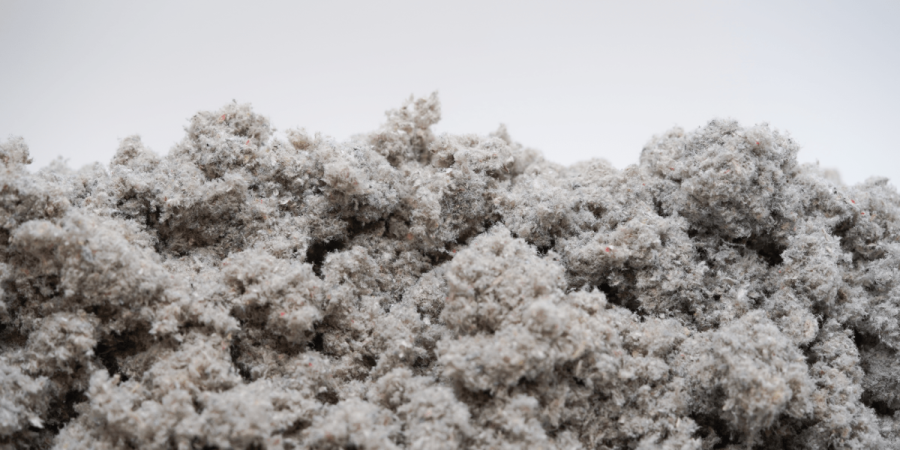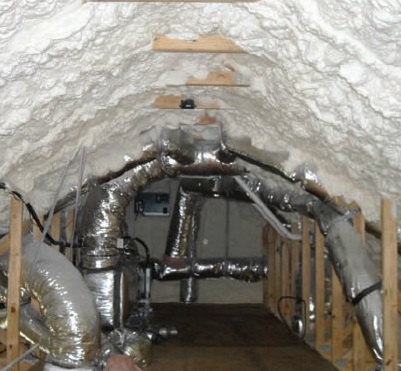Attic Insulation In Phoenix Ranked From Best To Worst
Attic insulation in Phoenix and throughout the Valley was an afterthought in the minds of builders for many decades. However, if you are sweating in a poorly insulated house – insulation is top of mind!
The Six Types Of Attic Insulation In Phoenix
If you live in the Valley, you likely have one or more of the following products in your attic.

Open Cell Spray Foam Insulation
A lightweight plastic material spray applied as a liquid to the underside of the roof. The fluid expands and turns into foam insulation. In Phoenix attics, spray foam insulation is typically 5.5″ deep.

Blown-In Cellulose Insulation
Manufacturers use recycled newspaper fibers to make cellulose insulation. Also, they add fire and mold proofing chemicals to the cellulose. Cellulose is installed 10-12″ deep by blowing it into the attic.

Blown-In Fiberglass Insulation
To make loose fiberglass, manufacturers lightly glue glass fibers into 1/4″ to 1″ chunks. Next, they pack the insulation into large bales. Finally, installers chop up the bales with a machine which then blows the fiberglass into the attic.

Fiberglass Batt Insulation
Fiberglass batts are the same material as loose fiberglass. However, in contrast to blown-in fiberglass, glass fibers in the batt are woven together to create a solid insulation piece. On the job site, technicians install batts by hand.

Mineral Wool Batt Insulation
Mineral wool batts are similar in size and texture to fiberglass batts. However, unlike fiberglass, manufacturers make mineral wool from molten stone spun into rock fibers. Thus, mineral wool is also called rock wool.

Loose-Fill Mineral Wool
Residential homes no longer use loose mineral wool or rock wool for insulation. But, if you have a home in the older parts of Sun City or the historic areas near downtown Phoenix, there is a good chance you have mineral wool in your attic.
The Best Attic Insulation In Phoenix Is Spray Foam Insulation
Spray foam insulation is the best product for Phoenix attics because it performs five functions. Those functions are:
- Blocks heat from entering the conditioned space.
- Prevents heat from entering the ductwork.
- Stops air leaks into and out of the conditioned area.
- Captures air leaks escaping the ductwork.
- Reduces HVAC capacity requirements
Unlike fiberglass or cellulose insulation, spray foam insulates as well as seals all air leaks. However, to properly air seal an attic, a spray foam insulation company must install foam to the manufacturer’s specifications.
Foam Attic Insulation Protects Ducts From The Phoenix Heat
Spray foam insulation contractors in Phoenix apply the insulation to the bottom side of the roof. Insulating the ceiling above the ducts is the same as placing a tight lid on a cooler packed with ice. When the cover is on tightly, the ice lasts for a long time.

Similarly, your ducts in the attic are inside the spray foam envelope. Consequently, the extreme heat does not enter the attic to heat the air in your ductwork.

Spray Foam Captures Air Leak In The Ducts
In most Phoenix homes, the attic insulation is below the ducts. Consequently, when your ducts develop small leaks, cool air is lost to the outside environment. However, foam insulation encapsulates the ducts within the interior of your home. Therefore, cool air lost via duct leaks does not escape outside.
Reduces HVAC Capacity
When you protect your ducts with spray foam, you don’t need as large an HVAC unit to cool the home. Additionally, your AC will run less. Which in turn extends the life of the HVAC system.
#2 Blown-In Fiberglass Attic Insulation
Blown-In Fiberglass Insulation Is Better Than Cellulose
Fiberglass insulation does not have the performance characteristics unique to spray foam. However, blown-in or loose-fill fiberglass is a better option for attic insulation than cellulose insulation.
Fiberglass Does Not Disintegrate
Unlike cellulose, fiberglass does not disintegrate into fine dust over time. As a result, it is a much cleaner product than cellulose. However, glass fibers can float suspended in the air. But, since they are much larger than cellulose dust, they cannot penetrate the living area easily.
Fiberglass Settles Slowly
Fiberglass settles slowly, losing its insulating properties over time. However, when properly installed and left undisturbed, fiberglass has twice the lifespan of cellulose.


Nowadays, Fiberglass Is Not Itchy!
If you’ve ever come into contact with fiberglass in the past, you probably felt itchy for a few days afterward. Fortunately, recent advancements in manufacturing eliminated the itchiness concern. So if you install fiberglass in your attic today, you don’t need to worry about itching for days afterward.


#3 Cellulose Attic Insulation
Most attic insulation in Phoenix is cellulose because it is the cheapest insulation product.
Unfortunately, due to how quickly cellulose disintegrates and generates dust, cellulose has developed a bad reputation. Consequently, cellulose manufacturers are careful not to use the word “cellulose” when they name their products. However, cellulose is easy to recognize due to its greyish brown color.
If your attic is exceptionally dusty, you have cellulose insulation.

When Correctly Installed, Cellulose Insulates Well
When installed over a sealed surface, cellulose insulates comparably to blown-in fiberglass. At least, initially. However, over time the performance gap between cellulose and fiberglass increases, with cellulose on the losing end.
Unfortunately, in Phoenix, cellulose attic insulation is rarely installed according to the manufacturer’s specifications. As a result, cellulose often doesn’t insulate to its full potential in Arizona attics.
A Leading Source Of Household Dust
Suppose you find layers of grey dust collecting on your HVAC supply registers. In that situation, you have a problem with cellulose dust entering the house.
Additionally, cellulose dust enters the house through ceiling fans, lighting, electrical switches, and outlets. Wherever there is an air leak between the house and the attic, cellulose dust will work its way through.
#4 Fiberglass & Rock Wool Batts
Fiberglass and rock wool batts are ideal for wall cavities and sealed roof joists. However, in an open attic, batts can only insulate between the trusses. Batts do not block heat transfer through the truss. Consequently, if you install batts in your attic, you will have a 1.5-inch gap with no insulation every 24 inches. That is over 6% of the attic area with no insulation at all!
When Batts Are Used For Attic Insulation In Phoenix, Proper Installation Is Rare
To install a batt correctly in an open truss, it must have a paper face. Next, insulators must staple the paper face to the bottom of the truss on each side of the batt. In Phoenix, most batt insulation does not have a paper face. On the rare occurrence that batts do have a paper face, they aren’t stapled in place. But rather, they’re loosely fit between the trusses.
When installers loosely fit batts between trusses, the batt loses contact with the drywall. Which, in turn, significantly reduces the fiberglass batt’s ability to insulate. Manufacturers require 100% contact with a sealed drywall surface to maintain the R-Value of the batt.

If you live in Phoenix and you have fiberglass batts in your attic, most likely, the batts are not insulating as well as they could.
#5 The Worst Insulation Is Incorrectly Installed Insulation
The lowest quality budget insulation will block heat from entering the house through the ceiling if you install it correctly. However, in Phoenix, attic insulation is rarely installed correctly. This unfortunate fact leads to the question:
Why is attic insulation installed incorrectly in most Phoenix homes?
The short answer is that builders in Phoenix never air-sealed the ceiling before installing insulation in the attic. You must install the insulation over a sealed surface for fiberglass and cellulose to perform to manufacturers’ specifications (R-Value). The performance of the insulation plummets when you install it over a leaky surface.
Insert a link to building America or energy.gov.
Most homes have dozens of air leaks between the living area and the attic. For example, air leaks are often located at every construction penetration through the ceiling in your home. Any plumbing, wiring, or framing in the ceiling can be a source of air leaks. So, before installing any insulation in your attic make sure you seal all the air leaks in the ceiling.
You Can Fix Your Attic Insulation In 3 Steps
Step 1: Vacuum out the old insulation.
Removing the old insulation is the most critical step. So, avoid the temptation to dig through old insulation to find the air leaks instead of removing the insulation. You’ll miss most of the leaks.
When you vacuum out the old insulation, you’ll be able to find all of the air leaks easily. Also, you’ll be able to seal each leak permanently.
Step 2: Seal all air leaks with canned foam & caulking.
Foam in a can has excellent adhesion and provides a complete air seal. Also, caulking works well in long skinny cracks along the top of stud walls. If you elect to install spray foam insulation, your contractor will seal the attic with the spray foam application.
Step 3: Install Your New Insulation
Your new insulation will perform to the manufacturer’s specifications when you install it over a sealed surface.
Final Thoughts
No matter what type of insulation you install, when installed correctly, it will improve the overall performance of your home. Therefore, your primary focus should be on correct installation. After that, you can determine which product works best for you.

